Coffee with Hazelnut Parkin
Italian meets Middle East on a trip to Yorkshire

I got pretty excited this Christmas ... a new drum machine, some comfy socks. Don't tell me you don't love a good sock, we all do.
One of the non-sock related items I received this year was a Silikomart Jr. Pillow. Now that January's finally up (phew) I've had a chance to road test it.
This recipe will seem like a bit of an odd ball, but stick with me - the flavours work really well together.
Putting ginger in coffee is common in Yemen and other parts of the Middle East, but was also done in 17th century England. Since I have a tiny amount of Yorkshire blood in my veins, I thought mixing up some Espresso mousse with Parkin would make a great combo. It's also served with those other classic babylonian coffee pairings - rose and cardamom.
As noted, this recipe is based on a Jr. Pillow mould - but any cake or loaf tin about 20 cm long, 7cm wide and at least 5cm deep would work too.
Ingredients (Makes 1 individual cake, serving 6 people with lots of meringues and some parkin for the chef)
For the Hazelnut Parkin
- 50g blanched hazelnuts
- 100g unsalted butter
- 125g self-raising flower
- 20g caster sugar
- 20g muscovado sugar
- 40g treacle
- 100g golden syrup
- 1 tsp ground ginger
- 35g whole egg (approximately half a large egg)
- 5g whole milk
- Pinch of salt
For the white chocolate espresso bavaroise
- 60g freshly brewed espresso
- 65g full fat milk
- 125g white chocolate couverture
- 30g egg yolks
- 15g caster sugar
- 190g whipping cream
- 3g gelatine (about 1 1/2 sheets)
For the coffee Crème au Beurre
- 50g caster sugar
- 15g water
- 30g egg yolks
- 30g egg yolks
- 110g unsalted butter
- 10g espresso powder or instant coffee
For the white chocolate flocking
- 200g white chocolate couverture
- 140g cocoa butter
- 4 teaspoons of superwhite food whitener (optional)
For the cardamom and rose meringues (optional)
- 4 large egg whites
- 130g caster sugar
- 130g icing sugar
- 5 cardamom pods
- 1tsp rose flavouring
- Dried rose petals
- Red and green food colouring
Equipment required
- Jr. Pillow mould or similar
- Thermometer
- Piping bags and nozzles for plating
- Silicone mat
- Stand mixer
- Sieve
- Stick blender
- Spray gun
Make the parkin
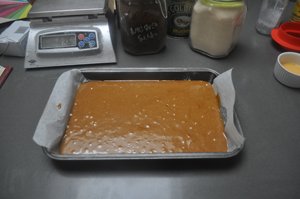
This is the best bit, as your kitchen will smell unreal.
Roast the hazelnuts at 200C for around 10 minutes, then crush roughly with your rolling pin or whizz quickly in a food processor.
Pre-heat the oven to 140C, then line a small brownie tin with greaseproof paper and some baking spray (or butter if you don't have any).
Place the butter, treacle, sugars, golden syrup and salt in a pot and, over a medium heat, stir until it's a thick liquid. Remove from the heat and leave to cool slightly.
Sieve the flour into a bowl, then add the ginger and roasted hazelnuts. Pour the sugar liquid over and beat with a spatula until it's all combined. Finally, beat in the egg and milk, then pour the lot into the tray.
Bake for 50 minutes, then remove from the oven and leave to cool completely.
Make the coffee Crème au Beurre
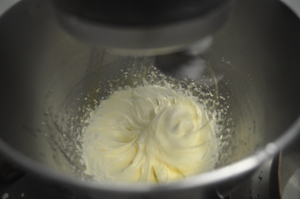
Place the egg yolks in the bowl of your stand mixer and whisk until pale. While this is happening, put the caster sugar and water in a pot, and heat to 121C
As soon as you're up to temp, carefully pour the syrup over the yolks and leave to whisk until it gains volume and is reasonably cool
Start adding the butter, piece by piece, with the whisk still running.
When all the butter has combined, take your espresso powder or instant coffee and blend it with a small amount of water to form a paste. Pour this into the mixture, and continue to whip until everything is combined.
Take your butter out of the mixer, and place into a tray of some sort - I used another brownie tin. Using a spatula or palette knife, form the butter into a block the same size as your mould. It should be around 1cm tall. Place in the fridge to firm up while you continue.
Make the espresso bavaroise
Soak the gelatine in cold water and set aside. Weigh your milk and espresso out into a heavy bottomed pan.Weigh out the white chocolate into another bowl with a fine sieve on top, and again set aside.
In a 3rd bowl, place the egg yolks and whisk them with the caster sugar until they become pale. Finally, get your thermometer ready.
Put the espresso milk over a medium heat until boiling. Carefully temper the egg yolks by pouring a little milk over them while whisking. Continue to add more until all the milk has been combined with the yolks.
Pour this back into the pan and keep stirring with a wooden spoon. Read the temperature - raise it until the thermometer reads 82 degrees C then immediately squeeze the liquid off the gelatine and whisk in. Pour the mixture through a sieve onto the chocolate. Let this sit for a few minutes, then use a stick blender to blend everything to ensure it's totally smooth.
When you're happy it's all blended, set aside in the freezer for 10 minutes to firm up.
Remove from the freezer, and whip the cream until quite thick - enough to hold its shape for a few seconds if you drop some from a spoon. Fold the cream into the custard.
If you're using the Jr. Pillow, pour the bavaroise up to the half way point of the mould. If you're using anything else, fill your loaf tin or other mould up to around 1.5 cm. Place in the freezer for at least an hour and reserve the rest of the bavaroise at room temperature. You might need to beat it now and again to stop it from setting during the hour.
Forming the rest of the cake

Remove the mould from the freezer. Again if you're using the Jr. Pillow it has a cutter in the top of it which allows you to chop out layers that fit inside it (yes, it's massively cool). Take this cutter and chop out identical pieces of parkin and the Crème au Beurre.
If you're not using the mould, measure and cut pieces of both layers which are around 1cm less wide than your original bavaroise layer.
Either way, place the Crème au Beurre on the parkin and line them up, then put them in the centre of the frozen bavaroise. Pour over the remaining bavaroise, making sure it drips down the sides and into any un-filled spaces. Put this back in the freezer for another hour or two to set.
Make the meringues (optional)
This bit's optional, but the meringues are delicious so I'd recommend it if you have time
Pre-heat your oven to 110C.
Place the egg whites in the bowl of your stand mixer and whisk until soft peaks form. Shower in the caster sugar at this point, then keep whisking until the meringue is glossy.
Stop the mixer, then sieve in the icing sugar. On the lowest speed, whisk again for 15 seconds (so the sugar doesn't fly up in the air) then push the speed up to max for another 30 seconds until the sugar is fully combined
Split this mix between two bowls then add red colouring to one, green to the other. Pour your rose flavour into the red mix. For the cardamom, split the pods by bashing them in a pestle and mortar. Remove the shells, then bash again until a reasonably fine powder is formed. Place half the powder into the green bowl and mix thoroughly.
Put each mix in a piping bag with whatever nozzle you prefer, then pipe small meringues onto silicone trays. Cover the rose ones with dried rose petals if you have some, and dust the cardamom ones with the remaining cardamom powder.
Place in the oven for an hour, then remove and leave to cool
Spray
Put the chocolate, cocoa butter and superwhite (if using) in a heatproof bowl and place over a simmering pot of water.When everything looks completely melted, blend with your stick blender just in case then pour into your spray gun.
Take out a big box - a 12-hole wine box is a good size - and cut off top flap. Lay it down so you have flaps on the left, bottom and right. Place a chopping board in the box, then put a layer of greaseproof paper on top.
Remove the cake from the freezer, and release it from the mould.
If you're ready to spray, put your cake in the box and turn on the gun. When flocking, I normally rotate the cake 3 times to make sure it has built up enough.
Return to the freezer to harden.
Reserve any unused spray for another time (it keeps quite well for a month or so in an airtight box).
To serve
Remove the cake from the freezer around an hour before you want to eat. If you want to cut slices, I'd recommend not doing that any later than 30 mins after it has come out of the freezer or it will start to melt.
Serve slices with the meringues on the side (if using) and enjoy this act of randomness.

Apple, Fennel & Rose Kouign Amann
Classic French viennoiserie with a toffee apple twist
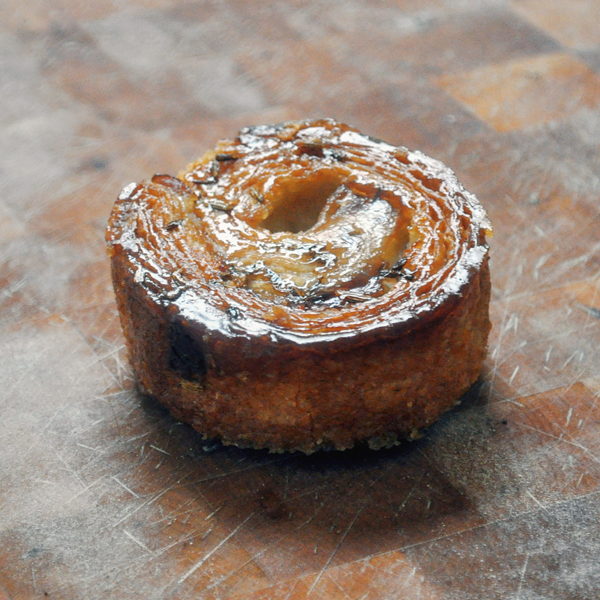
It was the hottest day of the year here in the UK yesterday - and I was out having meetings, fully suited up, sweating like a pig being eyed up by Mr. Koffman.
Strangely, we're supposed to be on our way to the Autumn equinox ... tell that to my apple trees, who's fruit should be ready for picking, but so many have spoiled in the heat.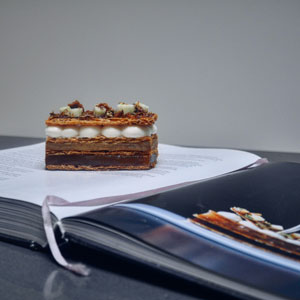
I made Heston Blumenthal's delicious "Taffety Tart" last weekend, and it gave me an idea - why not add the same apple, rose and fennel combination to something else.
Kouign Amann is a yeasted, butterry viennoiserie from Brittany made popular by GBBO a few years ago. The addition of thin apple slices and rose petals to the inside, with fennel seeds on the base gives the pastry an autumnal twist, caramelising the apples with a toffee-like flavour. I've used Bramley apples as I've got a ton of them - but also because they serve to cut through the sugar a little. I'm also resting the dough in the fridge overnight as is often the case with Croissants, which helps make them taste even better.
You're supposed to let them come to room temperature before eating - I challenge you that this is impossible after the smell fills your house.
Ingredients (makes 8 to 10 Kouign Amanns)
For the pastry
- 500g strong white flour
- 50g golden caster sugar
- 14g fast action yeast
- 200g room temperature water (~25°C)
- 50g room temperature milk (~25°C)
- 10g salt
- 100g unsalted butter - for the mix
- 250g unsalted butter - for the butter layer
For the apple puree
- 3 Bramley apples
- 50g golden caster sugar
- 100g water
For the roll in
- 100g golden caster sugar
- 3 Bramley apples
- 60g caster sugar
- 5g rose petals
For baking
- 100g golden caster sugar
- 25g unsalted butter
- 10g fennel seeds
Equipment required
- 10cm, 4cm tall tart rings
- Stand mixer
- Silicone mat
Make the dough
Mix the water, milk and sugar together then dissolve the yeast into this. Leave to stand for about 10 minutes until bubbly.Place your 500g of flour in the bowl of a stand mixer, and attach your dough hook. Pour in the yeast mix, and let it start running on a low speed until combined.
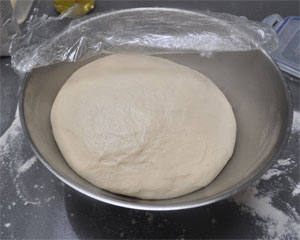 Slowly add the chopped butter, piece by piece followed by the salt. Keep it kneading for 8 minutes.
Slowly add the chopped butter, piece by piece followed by the salt. Keep it kneading for 8 minutes.
When it's ready, place into a clean, buttered bowl and cover with cling film. Let this stand until doubled in size - which will probably take 1 to 2 hours depending on your temperature or whether you put it into your proofing box.
Once it's ready, deflate the dough and flatten it into a rough rectangle. Cover it in cling film again, then place in the freezer for 30 minutes.
In the meantime, make your block of butter. Place a sheet of cling film on your work surface, then put your remaining 250g of butter (i.e. a pack!) in the middle. Cover with a second piece of cling film.
Begin to tap the butter with your rolling pin so that it softens. Eventually it will become pliable enough to roll into as perfect a square as you can. Use your hands on the upper piece of cling to straighten the edges if you need to. When you're happy with the block, place it into the freezer too.
Roll in the butter
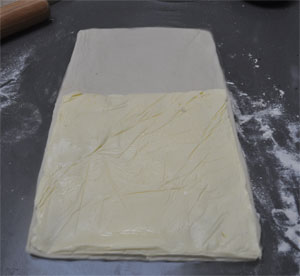 This next stage requires you to be reasonably precise with your rolling. What we're trying to do is keep the edges as straight as possible, and also to make the butter come up right to the edge - which means there won't be any part of our pastry without butter. These butterless points can create pockets which don't rise as well, so it's worth taking a time over this bit.
This next stage requires you to be reasonably precise with your rolling. What we're trying to do is keep the edges as straight as possible, and also to make the butter come up right to the edge - which means there won't be any part of our pastry without butter. These butterless points can create pockets which don't rise as well, so it's worth taking a time over this bit.
Roll out the now cold dough to as close as double the size of your butter block as you can get. If the edges aren't straight, try to re-form them with your hand or if you don't mind losing a bit of dough you can cut them off.
Remove the block of butter from the freezer, and take off the cling. Position it at the bottom half of your dough rectangle, then fold the top half over the top so that it's sandwiched in-between.
At this point, it should still be cold enough that the butter doesn't start squeezing out. Press down on the end of it do seal, then make a quarter turn with the dough (i.e. if the two ends of the pastry were facing you, turn it 90° so they move to being at a right angle to you).
Carefully roll the dough, in your body's direction, into a large rectangle about the length you made it when you were first inserting the butter block. Fold the dough, taking the furthest part away from you, and fold that 2/3 of the way back past the centre, then fold the remaining 1/3 back over the top of that (meaning you'll have 3 1/3 layers). This is turn one.
Wrap it back up in cling film, then return to the freezer for 30 minutes.
When time's up, repeat the fold process by placing the dough in front of you, with the seam you made in the last fold at a quarter turn away from you. Roll it out into a rectangle again, then perform the same 2/3 and 1/3 roll you made before. You've now made turn two.
Wrap it in cling - but this time place in the fridge and leave overnight to develop the flavours.
Make the apple puree
Peel and core the apples, then roughly chop. Place the water and sugar in a heavy based saucepan and add the apples.Let the apples simmer until they're really soft, then use a hand blender or food processor to blend them into a puree. Leave to cool then set aside.
Build the roll in
 Core and peel your remaining 3 apples. Cut in half, then Slice as thinly as you can (and I mean really thin!) - or use a mandolin if you have one.
Core and peel your remaining 3 apples. Cut in half, then Slice as thinly as you can (and I mean really thin!) - or use a mandolin if you have one.
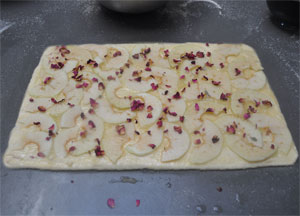 Take the dough out of the fridge and now we'll make one last turn. Repeat the fold process by placing the dough in front of you, with the seam you made in the last fold at a quarter turn away from you. Roll it out into a rectangle again, then perform the same 2/3 and 1/3 roll you made before.
Take the dough out of the fridge and now we'll make one last turn. Repeat the fold process by placing the dough in front of you, with the seam you made in the last fold at a quarter turn away from you. Roll it out into a rectangle again, then perform the same 2/3 and 1/3 roll you made before.
At this point it's worth cutting the dough in half, as it's much easier to handle two rolls of Kouign Amann pastry - it also means you can keep half the mix for another time if you want to freeze it. Wrap the half you're not using and place back in the fridge.
Take the other half and place on the work surface with the seam at 90° to you. Scatter 1/4 of the roll in sugar on top of this.
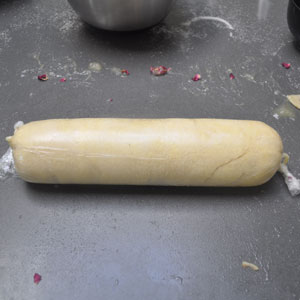 Roll the dough into a rectangle one final time, which will push the sugar into the dough.
Roll the dough into a rectangle one final time, which will push the sugar into the dough.
Place a sheet of cling on your work surface, and flip the dough onto it so that the sugar is now underneath. Brush over a thin layer of your apple puree, then scatter another 1/4 of the sugar all over this. Place slices of apple over the top, and finally scatter over the rose petals.
Now, from the longest side, start to roll the pastry, keeping it as tight as you can. When you've rolled it up entirely, bring the cling film up and over, then twist and hold the ends. Keep rolling it towards you in short strokes so that the pastry gets tighter in the middle.
Place in the freezer for 30 minutes. If you're making the other half of the dough now, repeat the process with the other half of the sugar, apples and rose petals.
Slice and proof
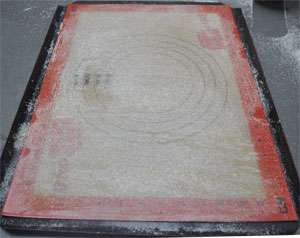 Toast your fennel seeds in a pan until they start to smoke, then remove from the heat and reserve.
Toast your fennel seeds in a pan until they start to smoke, then remove from the heat and reserve.
Heat 25g of butter, then place a silicon mat onto a heavy baking tray. Brush the butter over the entire tray, then scatter over your sugar. Shake so that it covers the entire mat. Pour any excess sugar back into a bowl.
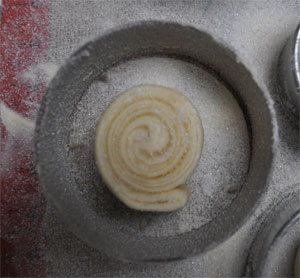 Take each pastry ring and brush it with butter too, then dip and roll each one in the bowl of sugar so that the insides are coated entirely. Place them on the mat, spread evenly, then scatter some fennel seeds inside each one and finally scatter over some more sugar (Note: Jamie Oliver would not approve).
Take each pastry ring and brush it with butter too, then dip and roll each one in the bowl of sugar so that the insides are coated entirely. Place them on the mat, spread evenly, then scatter some fennel seeds inside each one and finally scatter over some more sugar (Note: Jamie Oliver would not approve).
Remove a roll of pastry from the freezer and cut off the end. Now make slices around 2 1/2 to 3cm tall, trying to keep them as round as possible. Place each slice into one of the pastry rings.
Now leave to proof - it will take about 2 hours. Some time before they're done, pre-heat your oven to 180°C.
Bake
This is the fun bit that will have people running for your kitchen.When the pastries wobble a bit if you shake the try, they're ready. Place into your pre-heated oven and bake for 35 minutes.
After time's up, let them cool a little so that the caramelised sugar hardens.
Carefully pull each one up, breaking them out of the sugar. Trim the sides with a knife then gently push them down from the top so they fall out of the rings.
Leave to cool to room temp so they go really crispy. If you can stand to.
Seventy Five
A roasted pistachio and rose tartlet to celebrate my Dad's 75th

It was Dad's 75th Birthday this weekend; he's more than double my age, but still insists on balancing ladders on the top of ironing boards, just so he can pick an apple off a tree or destroy a wasps nest. I can only hope to be that able (though perhaps a little less insane) when I get there myself.
When I was young, some of my earliest memories are of my Mum roasting pistachio nuts in the oven, and Dad sitting down eating entire bags of them in one sitting - while somehow managing to stay under 10 stone in weight.
This recipe is a dedication to that memory; a roasted pistachio butter used to flavour sweetened cream, rose crème pâtissière, topped with meringues and another of his favourites - pistachio nougat.
You'll also get some bonus left over pistachio butter for your toast (just add salt or sugar), some meringues and some nougat to have later on.
Ingredients (makes 4 individual tartlets)
For the roasted pistachio butter
- 150g green pistachios (the proper Iranian ones if you can; I get mine from Sous Chef)
For the roasted pistachio cream
- 400g Whipping Cream
- 50g Icing sugar
For the rose crème pâtissière
- 3 large egg yolks
- 250ml whole milk
- 60g caster sugar
- 25g plain or type 45 flour
- 1 to 2 teaspoons of rose flavouring
- Powdered red food colouring (optional - you won't see it until you cut the tart open)
For the tart cases
- 250g type 45 flour [Buy] (or just plain if you don't have any)
- 140g unsalted butter (softened)
- 1 large egg
- 1 large egg yolk
- 40g ground almonds
- 90g icing sugar
- 1/2tsp almond essence
For the rose meringues
- 2 Large Egg Whites
- 65g Icing Sugar
- 65g Caster Sugar
- 1 teaspoon of rose flavouring
- Some crushed pistachio nuts and rose petals for decoration
For the pistachio nougat
- 210g Caster Sugar
- 50g Liquid Glucose
- 60g Honey
- 35g Egg Whites
- 50g Green Pistachio nuts
To finish
- Crushed green pistachios
- Reserved pistachio butter
- Rose petals
Equipment required
- 10cm tart rings
- 9cm circular cutter
- Stand mixer
- Thermometer
- Food processor
- Silicone mat
- Baking beans
- 30cm metal baking tray
- Plastic piping bag and large piping head
Make the roasted pistachio butter
 Turn your oven on to 170°C.
Turn your oven on to 170°C.
Weigh out the pistachio nuts onto a baking tray and, when up to temperature, place in the oven for 8 minutes.
When time's up, remove from the oven and pour into a food processor. Leave to blend for 10 minutes while still hot. You'll see the nuts crush, then get oily, solidify and finally blend into liquid. Stop and scrape down the bowl of your machine when it's liquid to make sure everything has been turned into a delicious pistachio paste.
Decant from the bowl and reserve. Once it's cool, place in the fridge. You can taste it if you like - but I promise it'll be so claggy you won't be able to speak; so maybe don't do that. Protip: If you're having the leftovers on toast, mix in some sugar or salt and that will reduce the sticky mouthfeel.
Make the pistachio cream discs
 When the pistachio butter has cooled, line a high-sided (at least 1/2 inch) baking tray with some greaseproof paper and give it a quick spritz of baking or 1 cal spray.
When the pistachio butter has cooled, line a high-sided (at least 1/2 inch) baking tray with some greaseproof paper and give it a quick spritz of baking or 1 cal spray.
Take the cream and whip with an electric whisk until soft peaks have formed. Shower in the icing sugar and whip again until almost firm.
Next, pour in about 2/3 of the pistachio butter. Whip for a couple of seconds more to blend - just don't overdo it and whip the cream too much; it should hold a shape and not be pourable. If you're nervous about over whipping, fold the pistachio in with a spatula instead.
Spoon the lot into a baking tray, then level off with an angled spatula. Try to get it as level as possible, then place in the freezer to solidify for about an hour.
The rose crème pâtissière
While the cream is freezing, make the creme pat.Place the eggs and caster sugar in a bowl and whisk until pale. Whisk in the flour until a smooth paste is formed. Add the colour at this stage if you're using it.
Pour the milk into a heavy bottomed pan, and heat until it nearly boils. Temper the eggs by pouring a small amount of the hot milk over them while whisking constantly to remove any possible lumps. Keep pouring more and more until all the milk and eggs are combined - then, return the mixture to the pan the lower the heat.
You can use a wooden spoon to continually mix until it's thick - but when making a heavy custard like this I prefer to whisk so that the flour has no chance of getting lumpy. When it looks thick enough to spoon, remove from the heat and pour through a sieve into a clean bowl. You'll need to push the custard through the sieve with the back of a spoon. Add the rose flavouring, and mix thoroughly.
Place cling film directly on top of the custard and leave to cool to room temp - then transfer to the fridge.
Make, bake and fill the tart cases
This recipe uses pâte sucrée.Attach a whisk to your stand mixer, and add the butter. Whip until the butter has been creamed, then add the almond extract, icing sugar, ground almond and eggs. When completely combined (i.e. no butter lumps), tip about 1/3 of the flour in. It should be combined in a few seconds, so repeat with the next 1/3 and then the final amount of flour. Stop the mixer when the mixture looks combined and a bit like wet sand, making sure you don't overwork it.
Turn this out onto your work surface and press it all into a smooth ball. Place the ball on some cling film, then flatten slightly with the palm of your hand. Wrap it in the cling and place in the fridge for at least 2 hours.
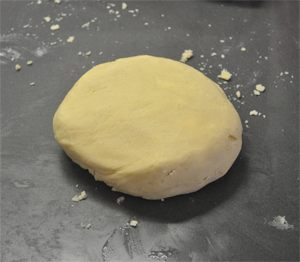

When the pastry has rested, take your baking mat and place it on a tray. Give the mat and rings a quick spritz with baking, 1 cal spray or just grease with butter.
Remove the pastry from the fridge, and unwrap from the cling. Stretch the cling film out, dust the pastry with icing sugar, then place back in the middle. Working really quickly while it's cold, roll the pastry on the cling film to a thickness of about 3mm. Check the width by putting the 4 flan rings on top - you'll need some excess around the edges of each. Cut the pastry into 4 equal pieces.
Remove all but one of the 4 pieces, then use the cling film under the pastry to pick it up, invert and place over one flan ring. Push the pastry into the corners - again, now that the cling is on top, you should be able to do this all by hand without further dusting. When you're happy, carefully peel the cling film off. Make sure any excess pastry is bent and folded over the edges of the case, and that no metal is visible on the upper rim. If it is, cut off some excess dough and push it into place. Sugar pastry is more forgiving than many other types, mainly because you can quite neatly blend any holes with extra pastry.
Repeat with the other four pieces, placing each one back onto the cling, inverting, then pressing in.
Turn your oven on to 170°C.
To help stop shrinkage, freeze the tart cases instead of just putting them in the fridge. Leave it in there for about 30 minutes (not much more - you don't want it to completely solidify) until nice and cold. When you're ready to blind bake, remove the cases from the freezer and place some silver foil (matte side down) into each one. Scrunch it down over the top edges so they are completely covered in foil, then gently pour in your baking beans into each one.
You need to add a bit of extra cooking time due to how cold they are; so bake for about 20 minutes. After this time they should look anaemic but be solid - so carefully remove the foil and beans, then brush with a beaten egg and return to the oven for a further 5 to 10 minutes until golden inside.
Remove and leave to cool to near room temperature, then use a sharp paring knife to trim the outer edge of each one. Carefully remove the rings, then brush out any pastry crumbs.
Make the meringues
 Turn your oven on to 110°C.
Turn your oven on to 110°C.
Beat the egg whites in your stand mixer until soft peaks form - normally less than a minute on a Kitchen Aid up at full whack. Slowly shower in the caster sugar, then leave it running on high for about 5 minutes until you have stiff peaks.
Turn the mixer down to low. Shower in the icing sugar and add the rose flavouring. Give it a quick 30 seconds on high, then turn off and transfer to a piping bag.
Take a baking tray, and place a silicone mat on top. Pipe tall-ish meringues by applying pressure to the bag and pulling upwards. Sprinkle half with crushed pistachio, and half with rose petals.
Place in the pre-heated oven, then cook for 60 minutes.
Make the nougat
Weigh the egg whites into the bowl of a stand mixer and attach the whisk. Line your high sided baking tray with cling film and sprinkle with icing sugar.Place the sugar and liquid glucose in a heavy bottomed pan with a thermometer, and heat to 135°C. At this point, spin up the stand mixer to full and whip the egg whites.
Carefully pour the honey in and heat to 145°C on your thermometer.
When reached, and with the mixer still running, pour the sugar mix onto the egg whites and whip until the mixer bowl feels just warm to the touch. Pour in the pistachios and mix for a moment.
Working quickly before it sets too much, scoop or pour the mix into your tray, sprinkle over some more icing sugar then let set. It will probably only take another 15 minutes.
When set, remove from the cling film and chop into small squares.
Put it all together
Take a tart case, and fill it with rose crème pâtissière right to the edge. Flatten with a spatula.Remove the pistachio cream from the freezer and cut a piece out with your circular cutter. Roll in the crushed nuts, then place on top of the tart case.
Take two pieces of nougat and place those on top of the pistachio disk. Dot over some pistachio butter, then add two or three of each type of meringue. Finally, sprinkle over a few more crushed nuts and some rose petals.
Serve when the cream has thawed - during the summer it will only take about 20 mins at room temp.









